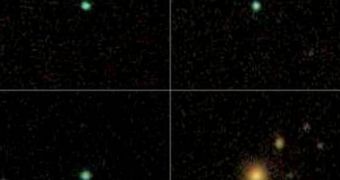At locations between 1.5 billion and five billion light-years away, amateur astronomers have recently discovered a new class of small galaxies, which they dubbed “Green Peas.” The tiny formations, which are up to 100 times less massive than the Milky Way, and up to ten times smaller, are producing stars at an incredibly high rate, almost ten times as fast as our own massive galaxy. Professional astronomers believe that, by studying these formations, they could get more clues as to how star-forming processes might have looked like in the very early Universe, when not many galaxies were around.
“These are among the most extremely active star-forming galaxies we've ever found,” Yale University astronomy graduate student Carolin Cardamone argues. She has been the lead author of the paper accompanying the finds, which will be published in an upcoming issue of the journal Monthly Notices of the Royal Astronomical Society.
“They're growing at an incredible rate. These galaxies would have been normal in the early universe, but we just don't see such active galaxies today. Understanding the Green Peas may tell us something about how stars were formed in the early universe and how galaxies evolve,” YU Postdoctoral Associate Kevin Schawinsk adds. He is also one of the founders of the Galaxy Zoo, an online project that enlists the help of spare-time astronomers to classify galaxies in an online image bank, ScienceDaily informs.
To this point, the project has collected over one million images of galaxies, but, out of these, only 250 are Green Peas. “No one person could have done this on their own. Even if we had managed to look through 10,000 of these images, we would have only come across a few Green Peas and wouldn't have recognized them as a unique class of galaxies,” Cardamone believes. She has determined that amount of stars that is formed in this class of galaxies by analyzing the type of light it emits.
Volunteers with little to no astronomical background have provided invaluable assistance to the experts, browsing through vast amounts of data and collecting the relevant ones related to the Green Peas.

 14 DAY TRIAL //
14 DAY TRIAL //